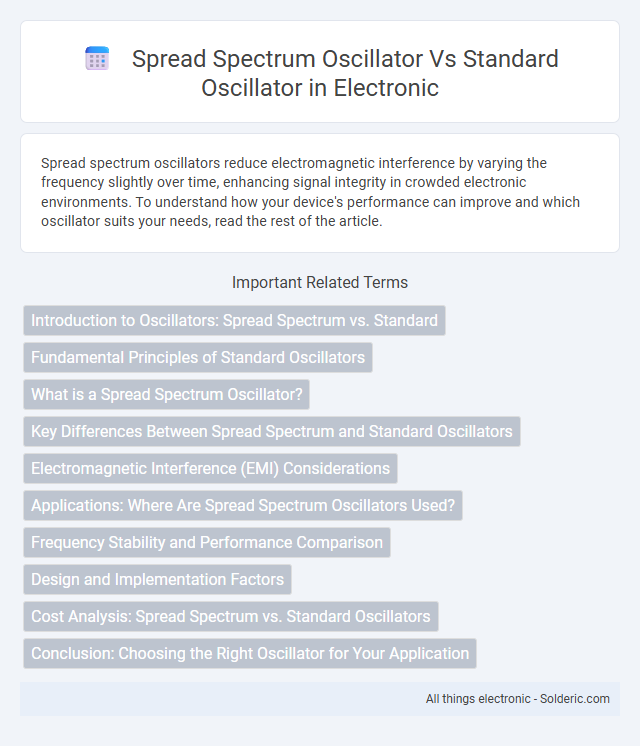Spread spectrum oscillators reduce electromagnetic interference by varying the frequency slightly over time, enhancing signal integrity in crowded electronic environments. To understand how your device's performance can improve and which oscillator suits your needs, read the rest of the article.
Comparison Table
| Feature | Spread Spectrum Oscillator | Standard Oscillator |
|---|---|---|
| Frequency Stability | Moderate stability with frequency modulation | High frequency stability and precision |
| Electromagnetic Interference (EMI) | Reduced EMI through frequency spreading | Higher EMI concentration at fixed frequency |
| Noise Performance | Lower peak noise by spreading spectrum | Concentrated noise at specific frequencies |
| Use Cases | EMI-sensitive environments, wireless systems | Precision timing, RF circuits, general purposes |
| Design Complexity | More complex due to modulation circuits | Simpler design and implementation |
| Frequency Range | Variable within modulation bandwidth | Fixed frequency output |
Introduction to Oscillators: Spread Spectrum vs. Standard
Spread spectrum oscillators modulate the frequency to reduce electromagnetic interference and improve signal integrity, unlike standard oscillators that maintain a fixed frequency output. Your electronic systems benefit from spread spectrum oscillators by minimizing noise emissions and enhancing performance in crowded frequency environments. Standard oscillators provide precise and stable frequency references ideal for applications where signal purity is critical.
Fundamental Principles of Standard Oscillators
Standard oscillators generate a stable sinusoidal signal by using a resonant circuit, typically comprising an inductor and capacitor or a quartz crystal, to produce a fixed frequency determined by the circuit's natural resonance. They operate on the principle of positive feedback, where a portion of the output signal is fed back to the input in phase, sustaining oscillations at a precise frequency. These oscillators prioritize frequency stability and low phase noise, making them essential for applications requiring accurate and consistent signal generation.
What is a Spread Spectrum Oscillator?
A spread spectrum oscillator is an electronic device designed to vary its output frequency over a wide range in a controlled manner, reducing electromagnetic interference (EMI) by spreading the signal energy across a broader bandwidth. Unlike a standard oscillator which maintains a fixed frequency, spread spectrum oscillators use modulation techniques such as frequency modulation (FM) or phase modulation (PM) to intentionally broaden the signal spectrum. This approach enhances electromagnetic compatibility (EMC) in sensitive electronic systems, making spread spectrum oscillators ideal for applications requiring minimized EMI emissions.
Key Differences Between Spread Spectrum and Standard Oscillators
Spread spectrum oscillators deliberately vary their output frequency within a defined range to reduce electromagnetic interference and improve signal security, unlike standard oscillators which generate a fixed, stable frequency. The key differences include enhanced EMI mitigation in spread spectrum oscillators, making them ideal for high-noise environments, while standard oscillators offer superior frequency accuracy and stability critical for precision applications. Your choice depends on whether minimizing interference or maintaining strict frequency stability is the primary requirement.
Electromagnetic Interference (EMI) Considerations
Spread spectrum oscillators significantly reduce electromagnetic interference (EMI) by modulating the frequency over a wider band, decreasing peak energy emissions compared to standard oscillators. Standard oscillators emit a concentrated frequency, resulting in higher EMI levels and increased susceptibility to regulatory compliance issues. Implementing spread spectrum oscillators is essential in environments requiring stringent EMI control, such as medical devices and communication systems.
Applications: Where Are Spread Spectrum Oscillators Used?
Spread spectrum oscillators are widely used in wireless communication systems, such as Wi-Fi, Bluetooth, and GPS, where minimizing electromagnetic interference and enhancing signal security are critical. Your devices benefit from these oscillators in environments requiring robust performance under noisy conditions, including avionics, military radar, and automotive applications. In contrast, standard oscillators are common in simpler electronic circuits where stable frequency output is needed without the complexity of interference mitigation.
Frequency Stability and Performance Comparison
Spread spectrum oscillators offer improved frequency stability by reducing electromagnetic interference through intentional frequency modulation, resulting in lower phase noise compared to standard oscillators. Standard oscillators typically provide a fixed frequency with higher accuracy but are more susceptible to noise and signal degradation in congested environments. Your choice depends on whether you prioritize minimal interference and overall signal integrity or maximum frequency precision.
Design and Implementation Factors
Spread spectrum oscillators utilize frequency modulation techniques to reduce electromagnetic interference, requiring complex design elements such as digital signal processors and wideband oscillators for effective implementation. Standard oscillators rely on stable frequency generation using crystal or LC components, emphasizing simplicity and precision in their circuit design. The implementation of spread spectrum oscillators demands advanced filtering, control algorithms, and greater power management compared to the comparatively straightforward and energy-efficient design of standard oscillators.
Cost Analysis: Spread Spectrum vs. Standard Oscillators
Spread spectrum oscillators generally incur higher initial costs than standard oscillators due to their complex design and advanced modulation techniques, which enhance electromagnetic interference mitigation. Standard oscillators offer a cost-effective solution for applications where electromagnetic compatibility is less critical, making them suitable for budget-sensitive projects. Your choice depends on balancing cost with performance needs, considering that spread spectrum oscillators can reduce overall compliance expenses by minimizing EMI-related failures.
Conclusion: Choosing the Right Oscillator for Your Application
When selecting between a spread spectrum oscillator and a standard oscillator, consider your application's sensitivity to electromagnetic interference and signal purity requirements. Spread spectrum oscillators reduce electromagnetic emissions by spreading the signal over a wider frequency band, making them ideal for environments requiring EMI mitigation. Standard oscillators provide stable, precise frequency generation suited for applications demanding high signal integrity without interference spreading.
Spread spectrum oscillator vs Standard oscillator Infographic

 solderic.com
solderic.com